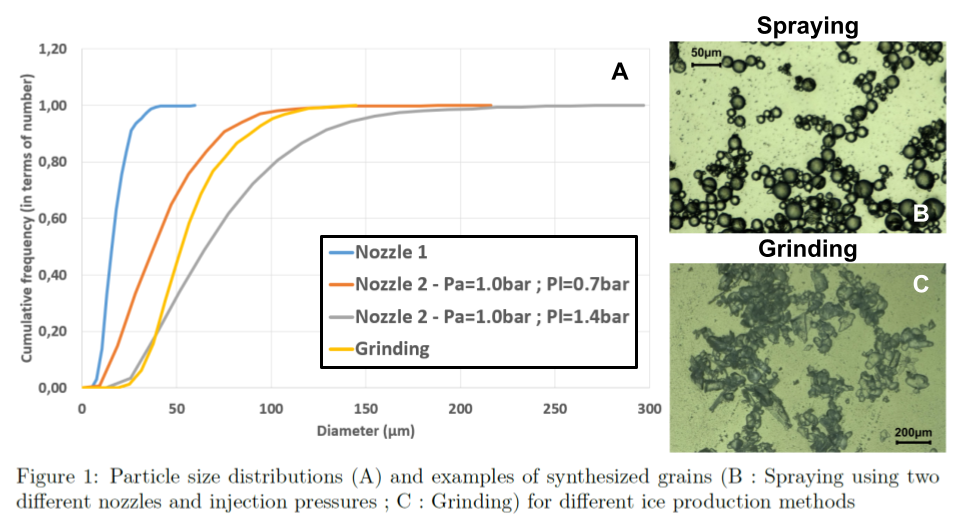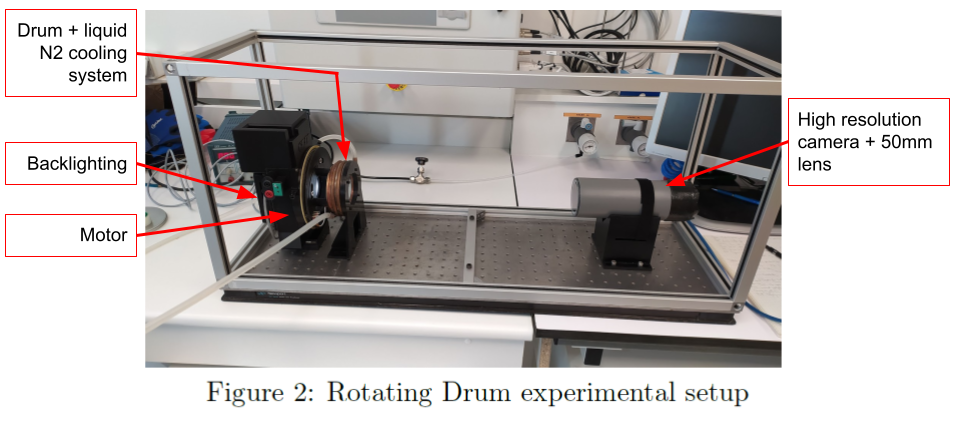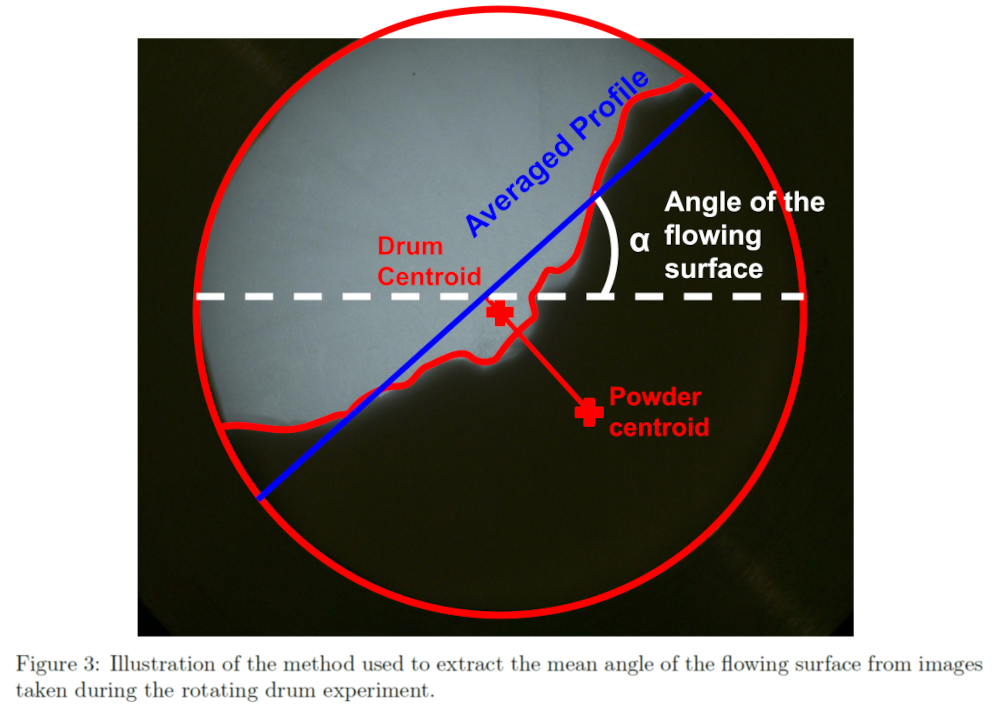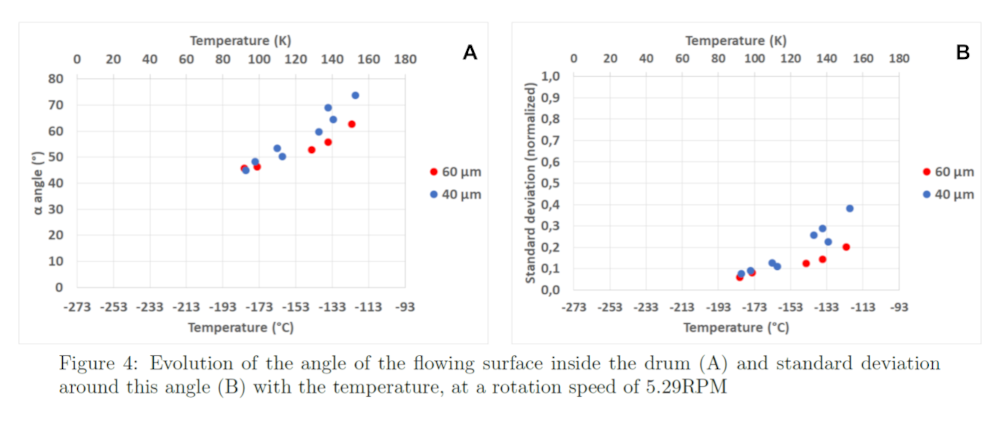The icy regoliths of Enceladus and Europa : experimental and numerical study
- 1MAST-GPEM, Université Gustave Eiffel, Bouguenais, France
- 2LPG, Nantes Université, Nantes, France
Acknowledgements
The present study received financial supports from the project GRIM funded by the Region Pays de La Loire (France) and from CNES for the preparation of the Europa Clipper mission.
Introduction
Most planetary bodies in the outer solar system are composed largely of water ice, which can behave like granular materials at their surface. These materials present a particle size distribution typically ranging between 10 and 100μm, which is the characteristic size of powders, a class of granular materials [1] that are subjects to potentially very high cohesion forces. This implies mechanical behavior different from those of more classical granular materials. In the particular case of Saturn’s moon Enceladus, jet activity resulting in the deposition of very fine ice grains (~10-100µm) at low temperature (~60-80K) suggest the formation of relatively stable powdery deposits [2]. Analogous processes could also be active on Europa [3, 4]. Characterizing the properties of these ice powders is essential for understanding the evolution of surface morphologies and anticipating the technical problems that future missions may encounter during landing and/or sampling of surface materials.
This study aims at characterizing the mechanical behavior of micrometric ice powders, on a wide range of temperatures, from Martian to Saturn’s moon conditions. The main goal is to quantify the evolution of internal parameters controlling the mechanical properties of ice powder, such as grain cohesion, with temperature, through various experiments. We will also use Discrete Element Method (DEM), a numerical technique in which a granular medium is simulated as multiple particles, interacting by means of contact laws accounting for the impenetrability of matter, friction, etc. Coupling experiments with DEM will place constraints on the properties of such powders, to then apply these results to icy surfaces.
Methods
We developed different methods to produce icy regolith analogue powders, with pure water ice grains of controlled sizes and shapes. A first method to produce analogs is to use a spray nozzle to create a fog consisting of water droplets, frozen in a liquid nitrogen bath (~77K), producing spherical grains with a size of a few micrometers to dozens of micrometers. A second method is to use a grinder, to produce angular grains with a wide range of sizes (dozens to hundreds of micrometers). A sifter allows to better constrain the grain size distribution.
The shape and size distribution of synthesized samples are analyzed using a numerical microscope, coupled with a cryostat to maintain our grains in controlled atmosphere (~80K and 10-1mbar) (fig. 1). We then use a liquid-nitrogen cooled rotating drum to perform dynamical measurements (fig. 2). The goal is to quantify the cohesion by analyzing the angle and irregularities of the flowing surface [5] on a wide range of temperatures (~80-250K). The more cohesive a powder is, the higher is the angle of the surface inside the drum, and the more irregular this surface is. We take several images of the ice powder inside the rotating drum, at multiple rotation speeds, and extract the angle of the surface for each image. We deduce a mean angle, and calculate a standard deviation around this angle, corresponding to a first level of irregularities as illustrated on fig. 3.



Results
The first measurements performed with the rotating drum on spherical grains ice powders (~40 and 60µm grain populations prepared from spraying at two different injection pressures, fig. 1) show an increase of the mean angle of the flowing surface, as well as an increase of the standard deviation around this angle, within the temperature range of 90 to 150K (fig. 4). This suggests that the cohesion significantly increases with temperature over this range, a surprising result on first look, but in agreement with other studies conducted at higher temperatures (>170K) [6].
We are currently developing numerical DEM simulations in support to the interpretation of the rotating drum experiment, focusing on the effect of cohesion or grain size. An increase of the cohesion in the simulations leads to the same behavior observed in experiments, an avalanche regime, a higher flowing angle and an irregular flowing surface. Decreasing the particle size tends to limit the effect of the walls of the drum, thus the formation of stable grain structures that could artificially give the same effect as an increase of the cohesion, such as an increase of the flowing angle.

Conclusion
First rotating drum experiments on spherical grains samples of pure water ice indicate a clear dependence of grain cohesion on temperature. Similar experiments on angular grinded grains are currently under development. Experiments will then be performed on more exotic powders, including salt-ice mixtures relevant for Europa and organic-ice mixtures relevant for Titan.
We are also developing another experimental setup, a cold cell to perform shear tests on a powder rheometer (Freeman FT4). This will allow us to get new sets of data, to better constrain complementary properties of the powder.
References
[1] B. Andreotti et al. (2013) Granular Media: Between Fluid and Solid. Camb. Univ. Press.
[2] M. Choukroun et al. (2020) Geophys. Res. Letters, 47(15).
[3] L. Roth et al. (2014) Science, 343:171–174.
[4] W. B. Sparks et al. (2017) ApJ, 839:L18.
[5] G. Lumay et al. (2012) Powder Tech., 224:19–27.
[6] G. Musiolik and G. Wurm (2019) ApJ, 873:58.
[7] B. Gundlach et al. (2018) Monthly Notices of the Royal Astronomical Society, 479:1273–1277.
How to cite: Jabaud, B., Artoni, R., Tobie, G., Le Menn, E., and Richard, P.: The icy regoliths of Enceladus and Europa : experimental and numerical study, Europlanet Science Congress 2022, Granada, Spain, 18–23 Sep 2022, EPSC2022-466, https://doi.org/10.5194/epsc2022-466, 2022.

